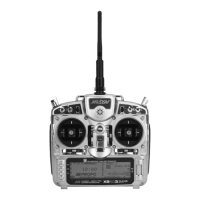1. Select Master. All Programmable Mixers default
to Throttle as both the Master and the Slave
(THROTHRO). The first THRO is the Master and
the second THRO represents the Slave. Since the
Aileron is the Master in this example, highlight the first
channel with the Selector and select AILE to the left
of the arrow.
2. Select Slave. Highlight and select THRO to the right
of the arrow to obtain a list of channels that can be the
Slave. Highlight and select ELEV as the Slave.
3. Select Position and Flight Modes. Move the Selector
to highlight each of the active flight modes (NRM,
ST1,ST2, ST3, ST4, GER, and then select the mix
position (0 or 1). Since the mix value will be in
position 1, the flight modes where the mix would not
be required would be set to the Pos0 mix position (will
be left at 0%).
The number will change from 0 to 1 as the switch is
moved back and forth. When the number is 0, the mixer
looks at the Pos0 values (not programmed yet) and when
it is a 1 it looks at the Pos1 values (also not programmed
yet). For this example, assume this mix will be used in
Stunt Modes 1 and 2 only.
4. Travel and Direction. Highlight Pos1 with the Selector
and press to access the values. Move the Aileron stick
to the full right position and the lower value next to
Pos1 should be highlighted. Set the lower Pos1
parameter to a low negative or positive value (check
elevator function for proper direction, you want up
elevator ) to a starting value of between 3% and 5%.
This is the amount of deflection of the Elevator (Slave
channel) that occurs when the mixer is turned on and
the Aileron is pushed Right.
Example: If the model ends in a nose-high attitude after a
right roll, set a value so that when Right Aileron is given,
the mix would provide a small amount of up elevator to
correct this problem.
If the model ends in a nose-down position after a Left
Roll, set a value so that when Left Aileron is given, the
mix would provide a small amount of Down Elevator to
correct this problem. The upper Pos1 value will then be
highlighted and can be adjusted as needed.
4. Offset. Leave the offset value to 0% for this mix, adding
0% corresponds to the center stick position.
Verify Proper Mix Operation. Move the Flight Mode switch
to the Stunt 1 or Stunt 2 positions, and move the Aileron
stick from center to full Right, and from center stick to full
Left. If the mix is activated and functioning properly, you
should see a slight Elevator servo movement (easiest to
see at the elevator servo arm) when the Aileron stick is
moved. Verify that the Elevator servo moves in the desired
direction to correct the trim problem at this time. Next,
switch the Flight Mode switch to the Normal or Throttle
Hold positions (set to off in this example), and verify that
the mix is being turned off for these desired flight modes.
The example below demonstrates a program mix for a
heli that pulls or climbs to the left when collective pitch
is added. If you set up a mix to provide a couple of
degrees of Right aileron when positive pitch is added, the
helicopter will climb vertically with no change in Aileron
trim. Once you advance the throttle below mid stick, the
mix doesn’t affect the Aileron trim unless trim in this
direction is needed and added to the mix.
This mix uses the Pitch as the Master and the Aileron as
the Slave. The mix can be turned on and off via the Flight
Mode switch, so you can activate the mix only in the flight
modes where the trim change is noted.
Select and set the Mix parameters in the following order:
Program Mix number (3–6), Master and Slave channels,
Mix Position and Flight Mode. This is generally a good
sequence to follow when setting up a Programmable Mix.
In this situation, the Offset value would remain at 0% (1/2
Stick).
1. Program Mix Number. Highlight and select one of
the Standard Programmable Mixers (PROG.MIX3 -
PROG.MIX6) to obtain the first Programmable Mix
display. Then press ACT next to CLR or highlight
and select INH to obtain the main mix display. The
example is PROG.MIX3.

